Intel Core Ultra Boost Overclocking Tested: Solid Gaming Gains
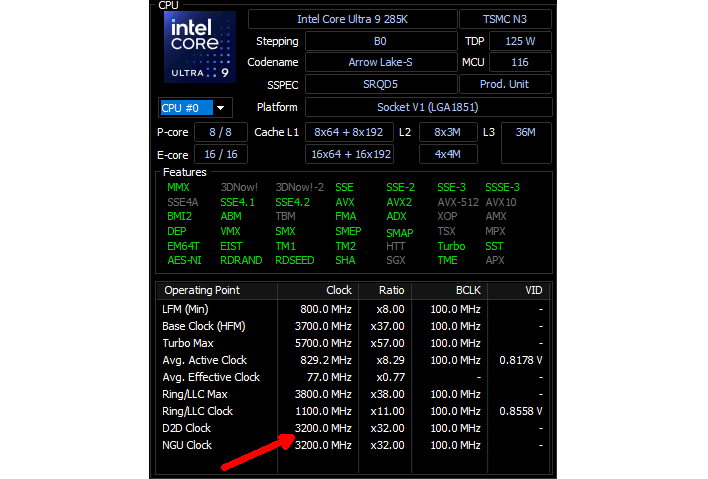
This screenshot from HWiNFO shows you the main difference between default settings and the Boost profile. By raising the System Agent voltage a bit, it's possible to drastically increase the "NGU" and "D2D" clock rates. NGU stands for Next-Generation Uncore, and refers to the clock rate of the CPU's I/O and memory controllers, among other components. Meanwhile, D2D stands for "Die to Die", and it's the fabric between the CPU's tiles.
This type of overclock isn't new, but enthusiasts noticed very soon after the launch of Intel's Arrow Lake desktop processors that increasing these clock rates could have an outsized effect on gaming performance. Intel's profile bumps them from 2600 (NGU) and 2100 (D2D) to 3200—a sizable jump for these components.

MSI released a new firmware for our MEG Z890 ACE motherboard containing the Intel Maintenance Release 1 update and the Intel Boost overclocking profile yesterday, so we decided we'd take a look at how well it works. We tested seven games across a variety of graphics APIs and game engines, and we came up with some pretty interesting results. Let's take a look, shall we?
Intel Core Ultra 9 285K Boost Mode In Cyberpunk 2077
We'll kick things off with Cyberpunk 2077, arguably the most popular benchmark of the last few years. For our testing in this piece, we've paired the Core Ultra 9 285K CPU with a Radeon RX 7800 XT, both because it is one of the fastest GPUs we had on hand and also because we've observed some odd scaling behavior with GeForce cards on this CPU. We wanted to present as fair a picture as possible, so we're testing in 1080p resolution, but with a relatively 'realistic' config that someone might actually want to use, not slammed-to-the floor settings.

In Cyberpunk 2077, we do see a very small but very consistent uplift in performance. We're not testing with the standard built-in benchmark here, but rather with a custom test performed by driving around in the Kabuki area of the Watson district. Because this test is a little bit non-deterministic, we make sure to perform the 60-second benchmark three times, and average the results. On average, Boost mode helps a little, but we're still GPU-limited here. The core Ultra 9 285K is fast in Cyberpunk.
Intel Core Ultra 9 285K Boost Mode In Shadow of the Tomb Raider

Shadow of the Tomb Raider is getting a little long in the tooth, but we like it as a benchmark because it can still tease out some interesting bottlenecks on poorly-configured systems. We tested in 1080p resolution using the "Highest" preset, and with ray-traced shadows manually enabled.

In this configuration, we did observe a consistent uplift of 2-6 average FPS, although the 1% lows didn't budge. This isn't much of a change, but it at least tells us that Boost mode isn't breaking anything.
Intel Core Ultra 9 285K Boost Mode In Oblivion Remastered

This full remaster of Bethesda's The Elder Scrolls Part 4: Oblivion just released yesterday, and so it makes a perfect candidate for benchmarking. We tested performance in the Imperial City's market quarter in the early morning, when a lot of NPCs are roaming around. We used 1080p resolution, with XeSS "Quality" mode, and the Ultra preset.

These numbers were surprisingly consistent considering the manual nature of the benchmark, but given that it's basically a margin-of-error difference, there's not much to see here. Oblivion Remastered is extremely heavy on the GPU on this preset; we might have seen more difference if we tested with a lower graphics preset, but given the absolute performance on display here we'd probably be turning settings up, not down.
Intel Core Ultra 9 285K Boost Mode In Zenless Zone Zero

Hoyoverse's post-apocalyptic action RPG uses an older version of the Unity engine that isn't terribly demanding, but can be quite thirsty for single-threaded performance in intense combat. We accidentally tested in the native 4K of our display instead of dropping it to 1080p, but the results are still useful and worth presenting.
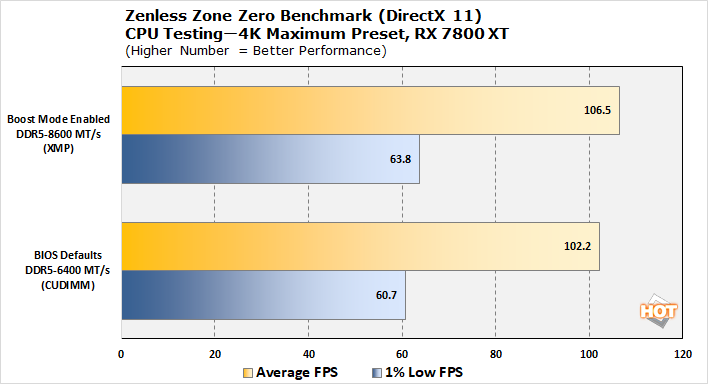
Indeed, across six runs of Trust: Threat from the Old Capital, we do see a small but measurable performance uplift in both 1% low FPS and average FPS. That's pretty good considering this is native 4K gameplay. If you're trying to push high frame rates on a Core Ultra CPU, you'll appreciate Boost mode in "ZZZ".
Intel Core Ultra 9 285K Boost Mode In Final Fantasy XIV

Of course, we couldn't leave out Final Fantasy XIV's Dawntrail 1.1 benchmark. That's in part because it's still a popular game that is extremely sensitive to single-threaded CPU speed, but also because it's simply very easy to run. Final Fantasy XIV showed huge performance disparities between the CPUs in our review of the Arc B570, so we expected it to gain quite a bit from Boost mode.
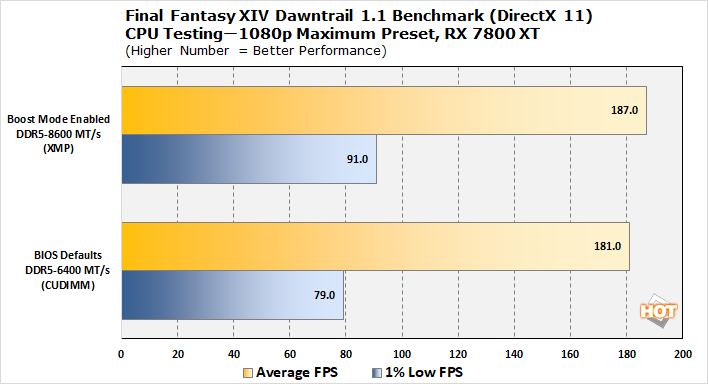
Indeed, in Final Fantasy XIV we see a solid 12 FPS jump in the 1% lows and a smaller 6 FPS jump in the average FPS from enabling Boost Mode. This is a huge improvement in smoothness in this title, and it's one of our best results, but it's not the last result.
Intel Core Ultra 9 285K Boost Mode In Baldur's Gate 3

Baldur's Gate 3 is another game that can be surprisingly sensitive to CPU performance, especially in the late-game, where players finally reach the titular city of Baldur's Gate. We tested with a custom benchmark that takes us halfway across the city, streaming in new textures, models, animations, and effects as we go.
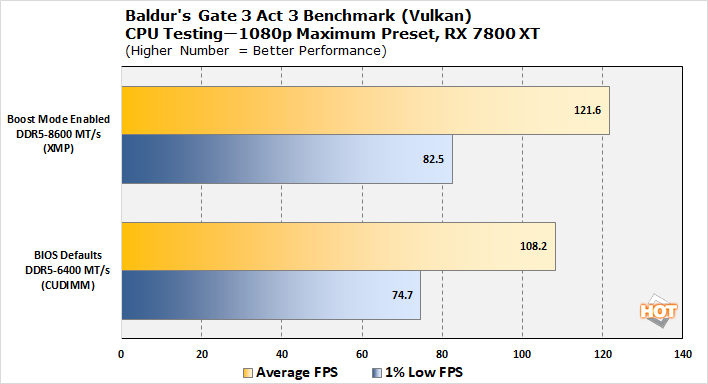
Baldur's Gate 3 also sees an excellent uplift from enabling Boost mode. Around a 10% gain in both 1% lows and average FPS, simply from toggling an option in your system BIOS, is nothing to complain about. There are virtually no downsides to enabling this feature, so this is essentially free performance for Core Ultra users.
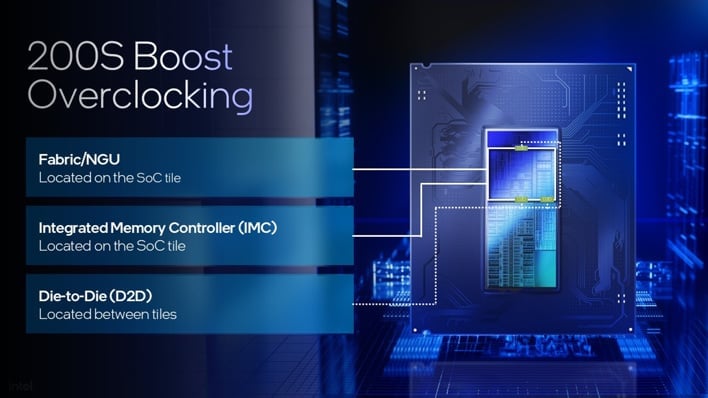
We say that because, while this will surely slightly increase power consumption—although we weren't able to verify a consistent difference on our end—it will not void your warranty. Intel has promised that it will cover supported processors that were used with Boost mode should anything go wrong, but frankly, the 1.2V VccSA that Boost mode sets is not of great concern anyway.
Kudos to Intel for working overtime to improve the weaknesses of its latest CPUs. While the Core Ultra 200 series CPUs are still pretty expensive (and not likely to get cheaper with the tariffs the way they are), Intel's efforts to improve and optimize the chips have made buying one feel less like a compromise and more like the proper current-generation flagship purchase it truly is. Let us know if you find any huge gains on your Core Ultra CPU by using Boost mode!



